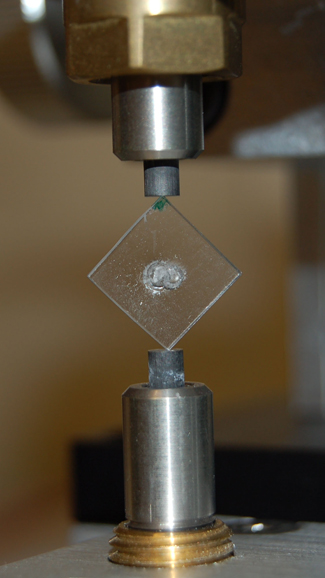Structural Transitions in Self-healing Materials Utilizing Resonant Ultrasound Spectroscopy
Kenneth A. Pestka II - kpestka@rollins.edu
Austin Ricci - aricci@rollins.edu
Rollins College
Department of Physics,
1000 Holt Ave, Campus Box 2743
Winter Park, FL 32789-4499
Stephen J. Kalista Jr. - kalistas@union.edu
Union College
Mechanical Engineering
807 Union St., Butterfield Hall 301A
Schenectady, NY 12308
Popular version of paper 4pPA4
Presented Thursday afternoon, October 29, 2009
158th ASA Meeting, San Antonio, TX
Poly (ethylene co-methacrylic acid) copolymers are among a unique class of materials that can self-heal after exposure to extreme environmental stimulus, such as the impact from a bullet shown in Fig.1 [1]. These thermoplastic materials utilize the energy of impact to reorient the polymer chains within the material, allowing near instantaneous closure and subsequent sealing of the damaged site. Thus, damage produced during an impact can be erased, at least partially, without the need to access the damaged system. These self-healing materials have potential use in a variety of exotic applications such as self-healing air cabins for aerospace vessels, fuel tank layers for combat vehicles, and emergency containment layers for chemical transport vessels and oil tankers.
In this experiment we were able to measure the time needed for completion of the sealing mechanism, which was approximately 5 to 7 hours, after which the samples reached a stable state. We were able to assess significant structural changes nearly invisible to the naked eye. The results of the experiment also indicate the technique is viable for measuring and characterizing other time-dependant properties of solid polymers and self-healing materials such as time dependant energy dissipation, material age effects and the influence of chemical composition on the healing mechanism.

Figure 1. A self-healing polymer sample after experiencing an impact from a bullet, the hole has completely sealed, adapted from [1]
Recent experiments on these copolymers indicate that two distinct time scales govern the evolution of the healing process: a molten elastic state, immediately after the damage, followed by a more slowly evolving sealing process via polymer chain interdiffusion [2]. One can think of the polymers chains within these materials as if they are long ropes which, when heated, become more flexible. The interdiffusion process is a product of these heated ropes becoming entangled and sticking together. Over time, it results in tight knitting of the damaged region.
In order to measure these changes during the second healing stage (polymer interdiffusion) and to characterize the rate at which energy is dissipated, resonant ultrasound spectroscopy (RUS) was utilized. The RUS technique enables the determination of a material's acoustic properties by examining the measured natural vibrational frequencies (resonances) of the material sample [3,4]. Every object exhibits a spectrum of resonances based on its structural properties. Thus by measuring the resonances or changes in the resonances, we are able to probe the material composition and how the system evolves over time.
In this experiment, the samples were damaged either by impact with a hammer or by penetration with the head of a nail. The sample resonances were then measured by placing the sample between two transducers as shown in Fig. 2. One transducer excited the sample and the other recorded the sample response. A broad range of frequencies is swept in order to determine the frequencies of maximum response (resonance). This process was repeated over several hours and, in some cases, days in order to observe the changes in the resonant frequencies as a function of time as illustrated in Fig.3.

Figure 2. The RUS cell, illustrating the placement of a ~11 mm self-healing sample between two transducers. A vibrational signal is sent in one transducer and the other transducer receives the sample response.

Figure 3. A partial spectrum of resonant frequencies from a self-healing sample after it has been damaged and placed in the RUS cell. The peak shapes at four different times are shown illustrating how the peaks changed over time.
The results indicate that these materials dramatically alter their polymer chain alignment for several hours after the initial impact clearly indicating that the rearrangement process extends well beyond the molten healing state of the system. In addition, the timescale for completion of the healing process, which is not apparent via visual inspection, was typically around 5 to 7 hours, after which the system remained stable. Furthermore, the experimental results indicate that by careful examination of the changes in the shapes of the resonant peaks the effects of energy dissipation, material age and variations in chemical composition can be probed.
References:
[1] S. J. Kalista, T.C. Ward, Self-Healing of Poly(ethylene-co-methacrylic acid) Copolymers Following Ballistic Puncture, Proceedings of the First International Conference on Self Healing Materials, Noorwijk aan Zee, The Netherlands: Springer (2007).
[2] S. J. Kalista, Self-Healing Ionomers, Self-Healing Materials: Fundamentals, Design Strategies, and Applications, edited by Swapan Kumar Ghosh, Wiley-VCH, Weinheim (2009).
[3] J. D. Maynard, "Resonant Ultrasound Spectroscopy", Phys. Today 49, 26 (1996).
[4] K. A. Pestka II, J. D. Maynard, D. Gao, C. Carraro, Measurement of the Elastic Constants of a Columnar SiC Thin Film", Phys. Rev. Lett. 100, 055503 (2008).